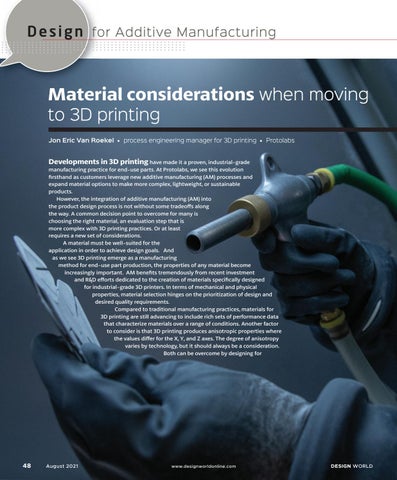•• •• •
•• •• •
•• •• •
•• •• •
•• •• •
•• •• •
•• •• •
•• •• •
•• •• •
D e s i g n for Additive Manufacturing •••••••••••••••••••••••••••••••••••••••••• •• ••
•• ••
•• ••
•• ••
•• ••
•• ••
•• ••
•• ••
•• ••
•• ••
•• ••
•• •• •• •• •• •• •• •• •• •• •• •• •• •• •• •• •• •• •• •• •• •• •• •• •• •• •• •• •• •• •• •• • • • • • • • • • • • • • • • • • • • • • • • • • • • • • •
Material considerations when moving to 3D printing
Jon Eric Van Roekel • process engineering manager for 3D printing • Protolabs
Developments in 3D printing have made it a proven, industrial-grade manufacturing practice for end-use parts. At Protolabs, we see this evolution firsthand as customers leverage new additive manufacturing (AM) processes and expand material options to make more complex, lightweight, or sustainable products. However, the integration of additive manufacturing (AM) into the product design process is not without some tradeoffs along the way. A common decision point to overcome for many is choosing the right material, an evaluation step that is more complex with 3D printing practices. Or at least requires a new set of considerations. A material must be well-suited for the application in order to achieve design goals. And as we see 3D printing emerge as a manufacturing method for end-use part production, the properties of any material become increasingly important. AM benefits tremendously om recent investment and R&D efforts dedicated to the creation of materials specifically designed for industrial-grade 3D printers. In terms of mechanical and physical properties, material selection hinges on the prioritization of design and desired quality requirements. Compared to traditional manufacturing practices, materials for 3D printing are still advancing to include rich sets of performance data that characterize materials over a range of conditions. Another factor to consider is that 3D printing produces anisotropic properties where the values differ for the X, Y, and Z axes. The degree of anisotropy varies by technology, but it should always be a consideration. Both can be overcome by designing for
48
August 2021
DfAM.8-21-Vs2.LL.indd 48
www.designworldonline.com
DESIGN WORLD
8/2/21 9:51 AM








